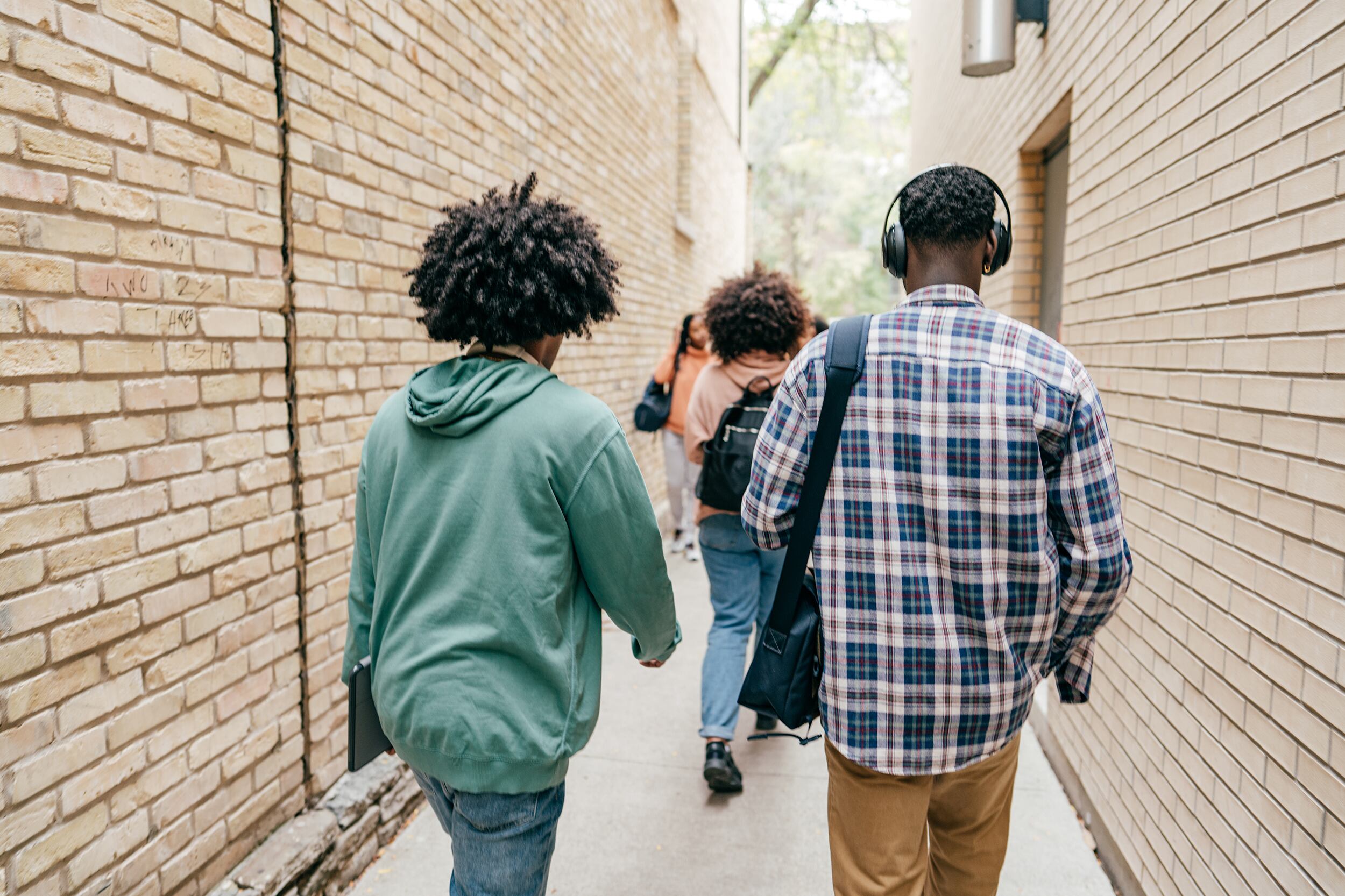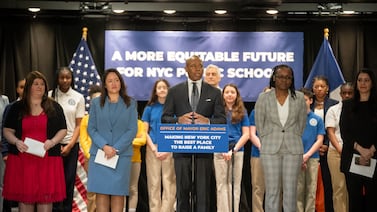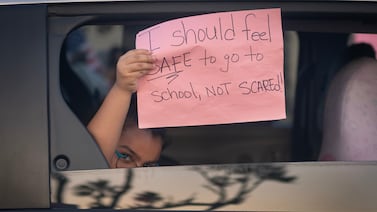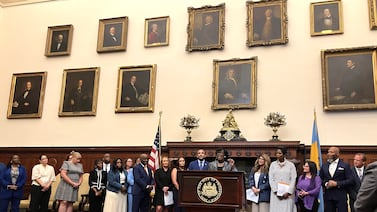Arlyssa Heard lived only a short distance away from her son’s school when he attended The School at Marygrove on the city’s west side. Her son’s commute by bike was less than 2 miles, but she was always worried about his safety.
“Him just walking the streets as a young Black male can sometimes yield all kinds of complications and dangers, and he doesn’t even have to be doing anything,” Heard said.
Most Detroit kids don’t attend their neighborhood school, making most of them ineligible for Detroit Public Schools Community District-provided bus service.
That means more than 24,000 DPSCD students must commute to school by walking, biking, or car. Another 47,000 Detroit students attend charter schools that provide little or no school bus transportation.
Detroit students face many dangers on their route to school: crime, violence, stray dogs, and dark areas. However, parents, neighbors, the city, DPSCD, and the Detroit Police Department focus more on one issue: slowing down cars.
What makes a route to school safer?
Keeping students safe while commuting to school starts with keeping the streets and sidewalks safe. Detroit had 66 collisions between pedestrians and cars in 2022 where a minor was hit, and the collisions are becoming more severe. In 2017, 6.4% were fatal. Last year, that number rose to 10.1%.
DPSCD spokesperson Chrystal Wilson couldn’t confirm how many district students walk or bike to school.
The city is attempting to make the city’s widest — and consequently, fastest — streets safer for cars and pedestrians walking alongside them. One way is by narrowing the roads. The 2020 Livernois Streetscape Project decreased the boulevard by one lane on each side, added bike lanes, created a dedicated left-turn lane, and widened the sidewalks.
A 2022 “Streets for People: Detroit Comprehensive Safety Action Plan” report recommended the city build curb extensions, add pedestrian countdown timers, and paint crosswalks on major boulevards to improve safety, similar to the work done on Livernois near Seven Mile. Since then, the city has begun a streetscape project for Dexter Avenue, Rosa Parks Boulevard, and East and West Warren avenues.
But drivers are still driving fast, and it can have severe consequences. A person hit by a car going 35 mph is five times more likely to die than someone struck by a car traveling 20 mph.
It’s not just how fast cars are going that can make kids unsafe on the way to school — it’s whether drivers can see them.
Daylight is still the best lighting. Michigan’s short winter days force students to spend more of their commute under the night sky.
Heard works as an education advocate with 482Forward. She and the organization are both pushing for a later start time, in part to keep kids safer on the way to school. Some DPSCD schools start as early as 7:30 a.m.
How DPSCD is addressing the problem
Even though it’s fairly obvious what kinds of things put kids getting to and from school in danger, it’s not as clear how to fix them.
For the last few years, the city and DPSCD have partnered with an organization called Michigan Safe Routes to School to help. The organization creates an action plan and helps find grants to implement changes.
SRTS Program Coordinator Adam Jenks said the program focuses on temporary or permanent speed bumps on residential streets, bike lane barriers, and long-term initiatives to narrow roadways.
“Our angle is to engage with the community,” Jenks said. “Get the parents, the staff, the faculty involved with going out and engaging with their students in the neighborhood, providing extra supervision at critical points where there might be higher incidences of speeding and things of that nature.”
In a SRTS survey sent to students and parents at the beginning of this school year, Jenks said responding parents were most concerned about the speed and amount of traffic.
Violence, crime and the presence (or lack thereof) of crossing guards also came up often. The survey data is not available to the public.
Wide roads and fast cars
Despite efforts to make streets safer for young pedestrians, the threats aren’t decreasing quickly enough. Students will be unsafe on their route to school until traffic slows down on those streets.
Tinu Usoro enrolled her oldest child at Joy Preparatory Academy for kindergarten. The school was within walking distance, but Usoro said it still felt unsafe to walk to school. Joy Prep is a few blocks south of the M-10 freeway and east of Livernois, two wide, fast-moving roadways.
There’s a lot of traffic in Detroit, both on freeways and city streets. Cars traveling at high speeds often fail to stop at stop signs or yield at intersections. The Southeast Michigan Councils of Governments found more than 80 intersections with a disproportionate number of pedestrian crashes within the city. Crashes at these intersections happen more frequently and are typically more severe.
Many of these locations coincide with Detroit Public Schools Community District schools.
The city implemented speed bumps to help address the problem, but they can only be installed on city-owned neighborhood streets.
There are many streets in the city that it doesn’t own, and that’s where many accidents happen. More than a third of all vehicle accidents involving a death or incapacitating injury occurred on just 3% of Detroit’s streets. These dangerous streets make up the “High Injury Network,” and 60% are owned by either Wayne County or the State of Michigan.
Crossing guards and the Detroit Police Department
A valuable part of SRTS’ action plan is advocating for crossing guards. The program can fund training and supplies for crossing guards at any school, but hiring those guards is at the city’s discretion.
Jenks said crossing guards are essential to a city’s safe transportation plan and are often “underappreciated.” Parents and students agree.
Research shows that crossing guards help reduce pedestrian accidents at crosswalks.
“During heavy traffic times at certain intersections, children don’t have the maturity to negotiate that traffic from one location to another,” said Sgt. Curtis Perry, who is part of the DPD Traffic Safety Unit. “We try to put crossing guards at those locations.”
Usoro transferred her kids to University Prep partially because of the crossing guards at the school, which makes the route to school feel safer. She said there are two crossing guards on University Prep’s campus during commute times.
The Traffic Safety Unit can hire as many crossing guards as they want, but Officer Eric Brown said intersections need a large amount of traffic combined with many students who cross that intersection to get to school to get a crossing guard. There are currently more than 50 crossing guards in the city. Forty-five DPSCD schools out of 110 have official crossing guards. This doesn’t include schools that use volunteer crossing guards.
Brown said they wait for the community to tell them where crossing guards are needed before they hire more. You can reach the Traffic Safety Unit at 313-596-1457.
What parents and students can do
It’s often up to parents and students to fill the gaps and ensure students get to school safely. Usoro said the community should work to keep sidewalks clean and avoid littering. Heard said neighbors can and should form watch clubs to supervise students while they commute to school.
Teaching students the proper way to cross the street and the safest route to their school is good practice. Children who bike to school should learn how to change bike tires, treat minor scrapes, and lock their bikes. Students should also memorize emergency numbers and learn places they can go if they need immediate help.
The city recommends that parents register their children’s bikes. People can learn more about the city’s streetscapes project on the Detroit Department of Public Works website.
SaMya Overall is a reporter for Outlier Media. You can reach her at samya@outliermedia.org.







